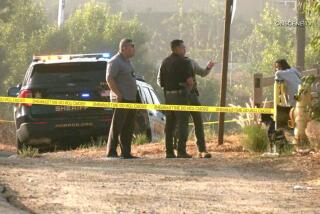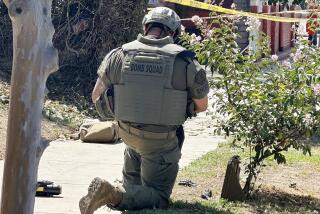Gang Violence Fuels Racial Tensions
Los Angeles Police Sgt. Larry Walker slowed his squad car, pointing to freshly spray-painted red gang graffiti on the side of a Baldwin Village apartment building, down the block from where a 3-year-old girl was shot and killed this week.
“Usually, kids are off limits,” he said, waving to a little boy with a red lollipop who eyed him back. “That little girl just got caught in the crossfire.”
Baldwin Village -- a neighborhood of run-down apartment buildings that take up less than a square mile between La Brea Avenue and Crenshaw Boulevard, off Coliseum Street -- has long struggled to shake its violent image. Two warring gangs occupy the area: the Black P-Stones, a mostly black gang, and 18th Street, a mostly Latino gang.
Police say area gang members are responsible for hundreds of shootings and robberies over the years. Though residents agree that the violence is mostly gang-related, some say the hostility has reinforced an undercurrent of racial tension among children and families.
In recent years, Police Chief William J. Bratton selected Baldwin Village as one of several hot spots in the city to crack down on crime. He created a “Safer City Unit,” deploying dozens of officers to patrol the area and arrest gang members. The increased police effort led to a drop in crime.
But the killing of 3-year-old Kaitlyn Avila on a sunny Sunday afternoon as she arrived home from McDonald’s has heightened tension and fear among residents. Police said the girl’s father, 24-year-old Cesar Avila, was the target but was not a gang member. He was shot multiple times in the upper body and remains in critical condition at UCLA Medical Center. Police said the two suspects, both African American, might have mistaken Avila for an 18th Street member.
For years, Walker has patrolled Baldwin Village. He grew up nearby in the 1960s when the area was mostly Japanese and black. Back then, he said, teenagers did not feel life-or-death pressure to join gangs, as they do now. Walker sighed as he talked about how it has changed.
“All this used to be extremely nice,” he said, driving past Baldwin Village apartment buildings whose pastel paint is crumbling.
He used to attend parties in the area when the buildings’ courtyards had large swimming pools. Now the pools are covered with concrete. He turned a corner, driving past a shuttered senior center with “BPS” scrawled across its front.
“It used to be an upper-middle class neighborhood,” Walker said, “Mostly white and black.”
Baldwin Village used to be called “the Jungle” for its tropical trees and foliage, like the palms, banana trees and begonias that thrived among tropical-style postwar apartment buildings.
The Los Angeles City Council changed the name 16 years ago, after residents complained that it reinforced the neighborhood’s image as a wild and menacing place. They renamed it Baldwin Village, hoping to reflect the affluent and peaceful -- mostly black -- Baldwin Hills neighborhood nearby.
Walker turned up a winding Hillcrest Drive, climbing toward million-dollar homes. Ray Charles used to live up here, he said. About a mile from Baldwin Village, it is one of the wealthiest black communities in the city, home to prominent judges, lawyers and television personalities.
Walker said residents in Baldwin Hills wave and smile when they see his squad car. They flag him down whenever they notice something suspicious, such as a car that has been parked on the street too long. He kept driving, past big homes decorated with rose beds and bird of paradise flowers. “Out of my price range,” he said, passing a Mercedes parked in the driveway.
He stopped at the top of the hill and stared at a stunning view of the city.
“You’ve got the contrast,” he said. “Baldwin Village over there. And you go across the street, and you have this.”
Heading back down, Walker said Baldwin Village began to change in the late 1960s and ‘70s. White flight began after the 1965 Watts riots. Drug dealers set up shop in an alley between apartment buildings where they sold PCP. They called it “Sherm Alley.” Soon the drug trade changed to crack cocaine, he said, and everything went downhill.
The Black P-Stone gang ruled the narcotics scene in the area. High-rent apartment buildings turned into subsidized, low-income housing. Latino families, mostly immigrants, moved in.
“The regular working ones were cool,” he said. “But then the 18th Street [gang] moved in and basically wanted to take over the drug trade.”
Walker drove along Pinafore Street, past Hillcrest Elementary School. Teenagers stared him down. No one waved. Walker said sometimes the glares remind him of a scene out of the movie “Training Day,” which was filmed in Baldwin Village.
A television news crew stood near a memorial of pink carnations, Jesus candles and rag dolls on the grass -- the spot where Kaitlyn was killed.
The pink and yellow bedroom Kaitlyn shared with her 6-year-old sister, Kassey, overlooks the memorial. Kassey was in the car with her father and sister when the shooting occurred. On a recent morning, the family looked at old photos of Kaitlyn spread across a coffee table.
“She was sweet.” said her aunt, Dulce Hernandez, 16, crying with her head in her hands. “She was smart.”
In her bedroom, Kassey looked at the Hello Kitty stroller her sister loved to play with.
“My sister died,” Kassey said. “I saw her in the street. The bad guys killed her.
“I heard popping,” she continued, “I was opening the door. I closed it. I got scared.”
“They were black.”
“Black guys with guns,” said her 5-year-old cousin, Sebastian.
Although Kaitlyn’s family has received an outpouring of support and prayers from black and Latino families in the neighborhood, some residents say the gang war has fueled racism in this neighborhood, where both races are struggling to understand each other. They say children sometimes repeat racial slurs they hear from gang members or on the street.
Karen Lira, 15, also lives in the neighborhood. She said some racial taunts have made her cry. “There’s a lot of racism,” she said. “African Americans don’t like Hispanic people.”
“Like the rest of L.A., it’s changing with more Latinos,” said Najee Ali, a black community activist who prayed with Kaitlyn’s family this week. “The neighborhood has racial tension. It’s increasing. Each ethnic group doesn’t understand each other’s culture.”
School was letting out as Walker drove through Baldwin Village. A boy walked past the memorial with his mother. He shouted, “Somebody got killed!”
A call came over Walker’s police radio: “Man with a gun.”
Walker sped across Coliseum Street, not far from Kaitlyn’s memorial site, and stopped at a police barricade.
“He’s somewhere in there,” an officer said to Walker as he pointed to a stretch of apartment buildings surrounded by sidewalks and streets. “Weapon is still on him.”
Walker surveyed the neighborhood. No telling where the suspect had gone. Everywhere he looked, children with backpacks walked home from school.
More to Read
Sign up for Essential California
The most important California stories and recommendations in your inbox every morning.
You may occasionally receive promotional content from the Los Angeles Times.










